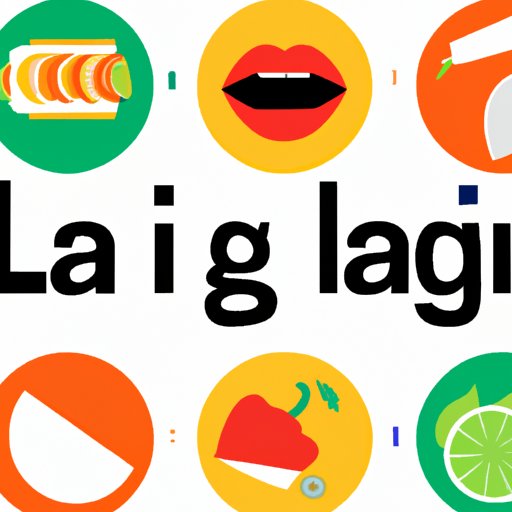Introduction
Learning a new language can be intimidating, especially when you’re just starting out. But don’t let that stop you from learning Spanish! Spanish is one of the most widely spoken languages in the world, with over 400 million native speakers. It’s also the official language of 21 countries, so if you ever plan to travel or do business in Latin America, it’s definitely worth learning. This article will provide an overview of how to say “I eat” in Spanish, including a beginner’s guide to conjugating the verb “comer,” tips for speaking Spanish quickly, and resources for additional practice.
A Beginner’s Guide to Saying ‘I Eat’ in Spanish
The most common way to say “I eat” in Spanish is “Yo como.” The verb “comer” is a regular -er verb, which means it follows the same conjugation pattern as other -er verbs, such as “beber” (to drink) and “leer” (to read). To conjugate “comer,” all you have to do is drop the -er ending and add the appropriate ending for each subject pronoun. For example, if you want to say “He eats,” you would say “Él come.” If you want to say “We eat,” you would say “Nosotros comemos.”
Mastering the Basics: How to Say ‘I Eat’ in Spanish
When learning any language, it’s important to understand the basic grammar rules. In Spanish, there are a few basic grammar rules that apply to saying “I eat.” First, you must use the correct subject pronoun. Second, you must conjugate the verb correctly for each subject pronoun. And third, you must use the correct form of the verb “comer.” For example, if you want to say “She eats,” you would say “Ella come.”
To help you better understand how to say “I eat” in Spanish, here are some examples of the conjugated verb “comer”:
- Yo como (I eat)
- Tú comes (You eat)
- Él/Ella come (He/She eats)
- Nosotros comemos (We eat)
- Vosotros coméis (You all eat)
- Ellos/Ellas comen (They eat)
Tips for Easy Learning: Speak Spanish with ‘I Eat’
If you want to learn Spanish quickly, there are several strategies you can use. First, immerse yourself in the language by listening to Spanish music and watching Spanish movies and TV shows. Second, practice speaking Spanish every day. You can even start a conversation club or join an online language exchange. Third, use flashcards or an app to review vocabulary and practice your pronunciation. Finally, find a native speaker who is willing to help you practice and give you feedback on your progress.
Eating Out in Spanish: Learn How to Say ‘I Eat’
When you’re dining out in Spanish-speaking countries, it’s important to know the cultural etiquette. When ordering food, use the polite form of “you” (usted) and make sure to thank the waiter when you’re done. Additionally, you should make sure to say “I eat” in Spanish when ordering. For example, if you want to say “I would like the steak,” you would say “Quiero el bistec.”
It’s also important to note that in some Spanish-speaking countries, it’s customary to say “gracias” after each course. For example, if you order a sandwich, you would say “Gracias” after you finish eating it. This is a sign of respect and appreciation for the chef and waitstaff.
A Quick Tutorial on How to Say ‘I Eat’ in Spanish
Now that you know the basics of how to say “I eat” in Spanish, it’s time to put it into practice. Here’s a quick tutorial on how to properly use the verb “comer” in various contexts:
- When you’re talking about yourself, use the singular form of the verb “comer”: Yo como.
- When you’re talking about someone else, use the third person singular form of the verb: Él/Ella come.
- When you’re talking about a group of people, use the plural form of the verb: Ellos/Ellas comen.
- When you’re talking about a group of people that includes yourself, use the first person plural form of the verb: Nosotros comemos.
Get Fluent Fast: Learn How to Say ‘I Eat’ in Spanish
Once you’ve mastered the basics of how to say “I eat” in Spanish, it’s time to take your language skills to the next level. To become fluent in Spanish, you need to practice regularly and challenge yourself. Try reading books and newspapers in Spanish, attending Spanish classes, and using online resources such as Duolingo and Babbel. You can also use apps like Memrise and Lingvist to help you learn new words and improve your pronunciation.
In addition to these resources, there are plenty of online communities where you can practice speaking Spanish with native speakers. These include forums, chat rooms, and social media groups. Joining these communities can help you make friends and practice your Spanish skills with people who share your interests.
Conclusion
Saying “I eat” in Spanish doesn’t have to be difficult. With a little bit of practice, you can master the basics of the language and become fluent in no time. Remember to use the correct conjugations of the verb “comer,” practice speaking Spanish every day, and take advantage of the many resources available to help you learn. With dedication and hard work, you’ll soon be able to enjoy all the benefits that come with knowing how to say “I eat” in Spanish.
(Note: Is this article not meeting your expectations? Do you have knowledge or insights to share? Unlock new opportunities and expand your reach by joining our authors team. Click Registration to join us and share your expertise with our readers.)
